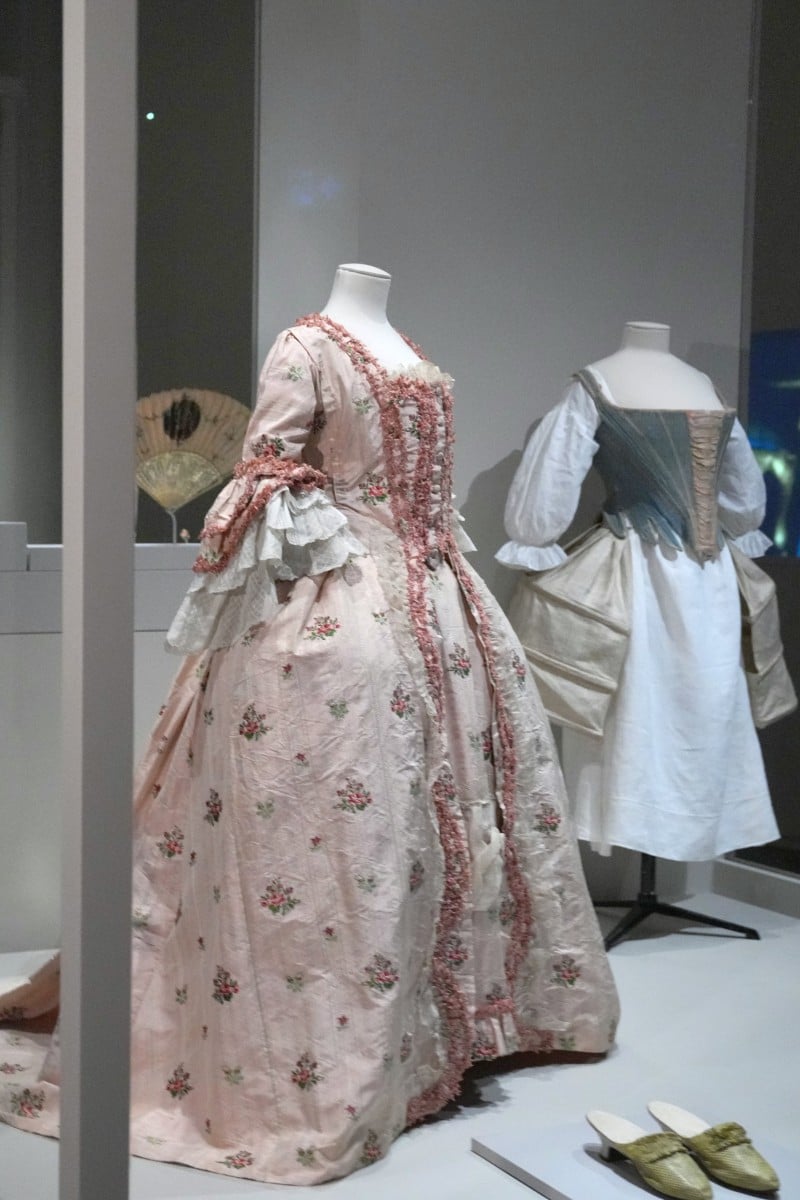
Historical French fashion on display at Hong Kong Palace Museum
- Collection of clothes, jewellery and accessories from the Musée des Arts Décoratifs in Paris showcases timeless pieces that continue to inspire today
 Singer and actress Karen Mok, who narrated the audio guide for the exhibition, poses with a French silk dress dating back to about 1770 at “The Adorned Body: French Fashion and Jewellery 1770–1910” at the Hong Kong Palace Museum. Photo: May Tse
Singer and actress Karen Mok, who narrated the audio guide for the exhibition, poses with a French silk dress dating back to about 1770 at “The Adorned Body: French Fashion and Jewellery 1770–1910” at the Hong Kong Palace Museum. Photo: May TseCorsets, panniers, and hoop skirts – these iconic, body-sculpting garments have cycled in and out of fashion since they were first popularised in the 1700s. From Brie Larson’s invisible hoop skirt at this year’s Met Gala to Billie Eilish’s corset gown in 2022, historical fashion has found new life in today’s pop culture, inspiring younger generations worldwide.
These timeless fashion spectacles from France are now on display at the Hong Kong Palace Museum (HKPM). “The Adorned Body: French Fashion and Jewellery 1770–1910 from the Musée des Arts Décoratifs, Paris” explores the history of French fashion for both women and men, spanning from the late 18th to the early 20th century.
This fashion exhibition marks the Asian debut of the prestigious French museum’s most comprehensive collection of historical French fashion, showcasing nearly 400 pieces of costumes, jewellery and accessories.
The exhibition is divided into five sections: Court Splendour (1770 to 1790), which showcases the dresses, suits, jewels and rare accessories used to denote status at the French court; Sense and Sensibility (1810 to 1830), Tradition and Innovation (1850 to 1860), The Birth of Luxury (1880), and The Belle Époque (1890 to 1910).
Ingrid Yeung, associate curator at HKPM, said that unlike traditional fashion exhibitions that predominantly showcase womenswear, this show also includes menswear.
What makes the exhibition so compelling is its demonstration of how each look is created and adorned, she explained. Besides outerwear, the exhibition also displays the underwear worn by people in the past.
“When we think about a person’s appearance, I hope people will understand that it’s not all superficial; there are layers beneath it, and many aspects contribute to how one presents oneself – social identity, expressing emotions, and psychological state,” she said.
Notably, the first section features trendsetting womenswear at court in the 18th century, characterised by pastel colours and adorned with lace, ribbons and flowers. Meanwhile, the “Sense and Sensibility” section features silhouettes such as puffed sleeves, corseted waists and voluminous skirts, encapsulating the essence of the era.
Corsets, known as “stays” in the 18th century, along with panniers, were integral to women’s silhouettes in court fashion. However, the practice of corsetry, which cinches the waist and restricts breathing, prompted women to use vinaigrettes – a small container with a sponge soaked in a pungent substance – to revive their senses. This created a new category of accessories at the time.
In popular culture, Pirates of the Caribbean: The Curse of the Black Pearl (2003) captures the pain of this form of beauty – Keira Knightley’s character, Elizabeth Swann, dressed in a tightly corseted gown, falls off a cliff after being out of breath.
Denis Bruna, head curator of the fashion and textiles department at Musée des Arts Décoratifs, Paris, said this French collection also featured attire inspired by Asia.
The curator specifically chose an 18th-century indoor jacket made from Chinese silk, one of the most sought-after fabrics of the time, and a dressing gown inspired by a Japanese kimono.
“I also selected Indian pieces. It was very important to me to showcase the collaboration and cultural exchanges between Asia and Europe,” Bruna said.
He expressed hope that the show would inspire young fashion designers.
“I would be very happy ... if the young and new fashion designers who live in Hong Kong or [mainland] China come to visit the show and could take some inspiration,” he added.
Mathieu Rousset-Perrier, heritage curator of the Middle Ages, Renaissance, and Jewellery collections, highlighted the logistical challenges of transporting nearly 400 historical fashion pieces to Hong Kong.
Due to their fragility, each piece was carefully packed in costly crates that maintained a stable temperature during transport. The garments were given two days to acclimate to the local weather before they went on display.
“It’s because of the craft, the level of expertise, and the quality of the hand that goes into the pieces on display. I do hope that visitors will be able to enjoy them, see that, and experience that,” Rousset-Perrier said.
Besides the clothing and accessories, the exhibition also references films, such as The Leopard (1963), Somewhere in Time (1980), and Bel Ami (2012), providing a better understanding of how men and women dressed these garments in the past.
The audio guide for the exhibition is narrated by acclaimed singer and fashion icon Karen Mok and is available in Cantonese, English and Mandarin.
“The Adorned Body” is one of four major showcases in the West Kowloon Cultural District this year that marks the 60th anniversary of the establishment of diplomatic relations between China and France. The exhibition in Gallery 9 of the HKPM will run until October 14.
“The Adorned Body: French Fashion and Jewellery 1770–1910 from the Musée des Arts Décoratifs, Paris”
Hong Kong Palace Museum
8 Museum Drive, West Kowloon, Tsim Sha Tsui
Tickets cost HK$150 and can be purchased on the Palace Museum website. A special combo ticket, available for HK$220, allows visitors to also enter the Yuan Ming Yuan special exhibition on the same day.
